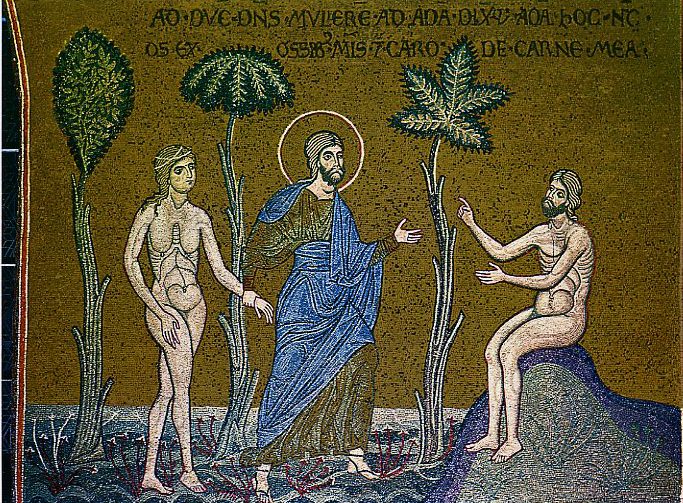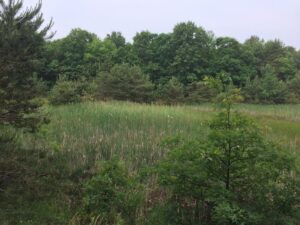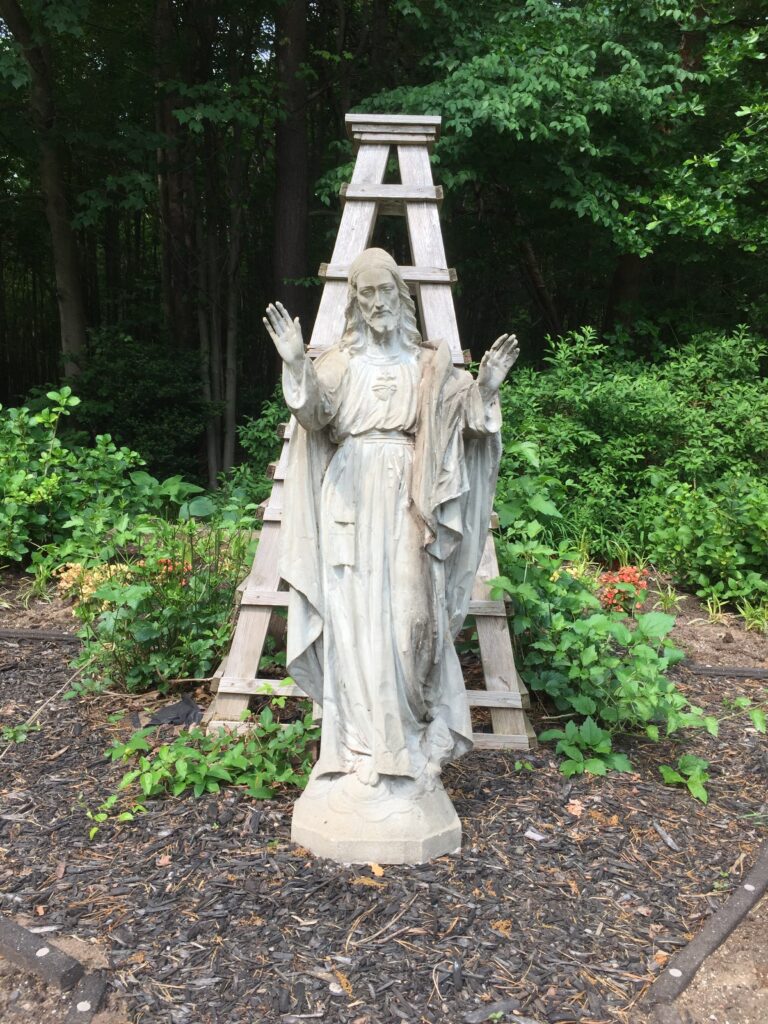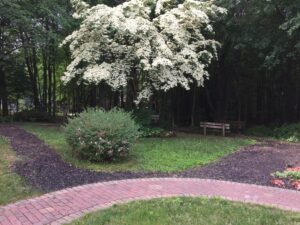Welcome to Our Lady of the Lake!
We are happy to share our beautiful prayer garden and parish grounds with our neighbors. We invite you to use these outdoor spaces for prayer and to enjoy God’s creation. You are also invited to pray in the chapel and to join us for Mass and other parish events. Learn more about the Catholic features of our prayer garden and other locations at our parish below. If you’re curious about Jesus and the Catholic Church, please contact us!
Why Pray in a Garden?
Two of the most pivotal events in salvation history took place in a garden. When God created the world and fashioned the first man and woman, he placed them in a garden and walked with them in perfect fellowship. Mankind rebelled against God, but he never stopped loving us and striving for reconciliation.

God walked with mankind once again when Jesus dwelt among us. Again mankind rebelled, killing the Lord and entombing his body in a nearby garden. Jesus rose from the dead and walked with men and women in that garden. By doing so, he began the restoration of all creation and the reestablishment of fellowship between God and mankind.

We invite you to reflect on God’s creation and redemption in our prayer garden. We hope that you will hear Jesus’ call to friendship with him and communion with his Church.
“On the third day the friends of Christ coming at day-break to the place found the grave empty and the stone rolled away. In varying ways they realized the new wonder; the world had died in the night. What they were looking at was the first day of a new creation, with a new heaven and a new earth; and in a semblance of a gardener God walked again in the garden, not in the cool of the evening, but in the dawn.” — G. K. Chesterton, The Everlasting Man
Rosary Path
The Rosary is a common Catholic prayer that combines the physicality of beads with vocal prayers and meditation on incidents from the life of Christ and the Blessed Virgin Mary. The main path of our prayer garden is laid out like the beads of a Rosary, and you are invited to pray as you walk. You can find guides to praying the Rosary and Rosary beads in the box by the east entrance to the garden. You can also find Rosaries and prayer pamphlets in the chapel.
Memorial Fountain
Running water reminds us of our rebirth in the waters of Baptism and the refreshment and life that comes from the Holy Spirit.
This fountain is dedicated to the memory of our departed loved ones. Catholics pray for the dead, asking God to forgive their sins and welcome them into heaven. You are invited to pray for your deceased relatives and friends in the garden.
Statue of Our Lady
Catholics revere the Blessed Virgin Mary, the Mother of Jesus, more than any other saint because she is closer to Jesus than any other human being. We do not give her or the other saints the worship that is due to God alone, but we honor them, ask for their prayers, and seek to imitate their holiness.
Mary is the Mother of the Church and the spiritual mother of every Christian. This statue helps us remember to honor our Blessed Mother and ask for her to pray for us.
Mass in the Prayer Garden
The Mass is the source and summit of the Christian life. We gather to hear the written Word of God in the Scriptures and then encounter the living Word of God, Jesus Christ, truly present in the Eucharist.
Mass is celebrated in the prayer garden at 9 a.m. on Thursdays between Memorial Day and Labor Day. All are welcome to worship God with us. If you are not a practicing Catholic in full communion with the Church, when it comes time for Holy Communion you may either remain in your seat or come forward with your arms folded across your chest to receive a blessing.
Ambo
The first half of the Mass is the Liturgy of the Word. Passages from the Bible, including a reading from the Old Testament and/or Epistles, a Psalm, and a Gospel reading are proclaimed from the ambo.
Altar
The second half of the Mass is the Liturgy of the Eucharist. This takes place at an altar because Christ’s sacrifice on the Cross is made present in the Blessed Sacrament. The priest consecrates bread and wine on the altar, and they become the Body and Blood of Christ.
Catholics bow toward the altar when entering and exiting a sacred space as a gesture of reverence for Christ, who is symbolized by the altar and who makes himself present on it. If the Eucharist is present, we genuflect (go down on one knee) as a gesture of worship.
Items needed for the liturgy are placed on the credence table next to the altar.
Presider’s Chair
Through the sacrament of Holy Orders, Catholic priests receive God’s grace to preside over the public prayers of the Christian community and to act in the person of Christ while celebrating the sacraments. This is apparent at Mass, where the priest leads the assembly in prayer and consecrates the Eucharist. When he is not at the ambo or altar, the priest sits or stands at the presider’s chair.
Crucifix
The image of Christ on the Cross reminds us of the great love Jesus showed for us by sacrificing himself for our sins. Crucifixes can also remind us to take up our own cross by uniting our sufferings with Christ’s. Crucifixes are often found near Catholic altars because Christ’s sacrifice is made present at the consecration of the Eucharist during Mass.
Benches and Pews
Feel free to sit on the benches located throughout the prayer garden. The rows of wooden pews facing the altar are used during Mass, but you can sit on them any time and contemplate the altar and the crucifix.
Statue of the Sacred Heart of Jesus
Christians use sacred art in their prayers because Jesus made God visible and tangible when he took on our flesh and dwelt among us.
Many images of Jesus, including this statue, feature his Sacred Heart, which is a symbol of his sacrificial love for mankind. The image of the Sacred Heart includes the Crown of Thorns, the bleeding wound in Jesus’ side, the flame of the Holy Spirit, and the Cross.
Statue of St. Francis
St. Francis of Assisi lived in Italy in the thirteenth-century. He is one of the most popular Catholic saints. Among other things, he is known for founding the Franciscan friars, bearing the stigmata (the wounds of Christ) on his body, and for his “Canticle of the Creatures,” which gives praise to God through creation. Because of this association with creation, statues of St. Francis are often found in gardens.
Stations of the Cross Trail
The Stations of the Cross is a prayer that follows Jesus as he went to his death on Calvary for our sins. Each station represents an event in Christ’s journey. Some are taken straight from the Gospels, while others have their origin in very old traditions passed down by Christians in Jerusalem. When Catholics pray the Stations we unite our sufferings with Christ’s, praise and thank the Lord for his sacrifice, and ask for the grace to renounce our sins. The Stations take the form of a mini-pilgrimage and are best prayed while walking. Therefore, many Catholic churches have images of the Stations for private and public devotion.
You are invited to pray the Stations of the Cross while walking the trail in the prayer garden. You can find a guide for praying the Stations in the box next to the first station, which is near the west entrance to the garden. You can also pray in your own way or bring another set of prayers with you.
Eucharistic Processions
The Solemnity of Corpus Christi is an annual celebration of Christ’s real presence in the Eucharist. Catholics believe that he is fully present in his body, blood, soul, and divinity, even though we cannot perceive him. On Corpus Christi, we have a procession with the Eucharist from the church to the prayer garden, where we adore our Lord in the Blessed Sacrament on the altar. Processions symbolize the way that the Lord leads his Church through history and walks with each of us throughout our lives.
Bathroom Access
You are welcome to use the parish bathroom during regular hours (8:30 a.m. – 2:30 p.m., Monday – Friday).
Dogs
Dogs are not allowed in the prayer garden, but you are welcome to walk your dog in other parts of the parish grounds, including the pond trail. Please clean up after your dog. Thank you!
Pond Trail
Behind our fire pit is a short, wooded trail that loops around a pond. It’s a beautiful spot to walk and pray with a friend, with your dog, or in solitude. Six signs have verses from Daniel 3 in which all creation gives praise to God.



Chapel
You are invited to pray in our chapel anytime it is open. The chapel is open 8:30 a.m. – 2:30 p.m. Monday through Friday, and before and after all weekend Masses.
We celebrate Mass in the chapel at 12:00 p.m. on Tuesdays and at 9:00 a.m. on Thursdays and Fridays. Adoration of Jesus in the Eucharist also takes place in the chapel, typically on Thursdays from 3-9 p.m. and the first Friday of each month from 9:30 a.m. – 9 p.m.
Many Thanks to Our Volunteers!
Our prayer garden is maintained by gracious volunteers who adopt a section of the garden to work on. Volunteers also help with lawn mowing and trimming, spring and fall cleanups, and annual planting. Contact the parish if you’re interested in helping! Many thanks to all the volunteers who have worked in the garden over the years; the Eagle Scouts who built the benches, pews, and arbors; and the Knights of Columbus, who built all of the liturgical furniture.



















